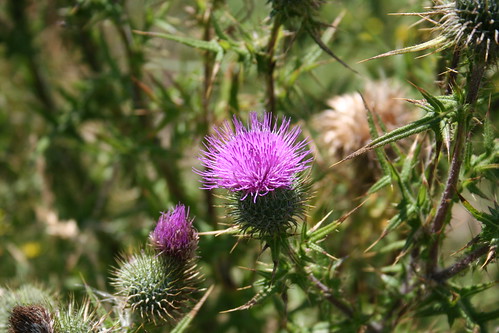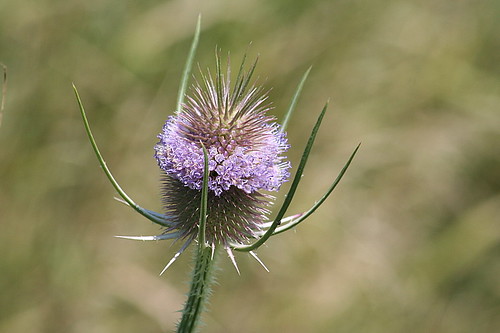 |
| 'Thistle clipart' search on Google yields this result - these are all thistles. Screenshot by BotanicalAccuracy.com. |
A typical thistle flower looks like this:
 |
| Thistle, probably Cirsium. Photo from United Kingdom, by John Cooke on Flickr (Creative Commons). |
The problem is the teasels (Dipsacus). They are in the family Dipsacaceae, not too far away from Asteraceae's thistles, but certainly not true thistles, but they look a bit like them and get confused with them a lot. Teasels also have large heads of small flowers and are plants that look ferocious with spines. The teasel itself got its name from that the flower heads were used to tease out the wool before spinning (carding). Several teasels are invasive in the United States and you often see them along highways in disturbed ditches and on road banks. Their flowering heads dry beautifully into gorgeous botanical stalks for flower arrangements.
A typical teasel look like this:
 |
| Teasel, Dipsacus. Photo by Bev Currie on Flickr (Creative Commons). |
So, can you tell teasels and thistles apart? Thistles have many (involucral) bracts below the flower head that form a cup below the flowers. In teasels, there are just a few long bracts that stick out below the flower head. The teasels have lots of sharp parts in the actual flower head, so the flower head looks like a spiny ball the whole season. In thistles, the bracts below the flower stays, but there are no persistent spiny parts inside among the flowers themselves. The fruits, which are little nut-like, single-seeded achenes have a feathery pappus for wind-dispersal in thistles, but are naked in teasels. Good teasel photos are available on invasive.org.
As usual for some of these misunderstandings and misapplications, the stock photo market is abundant with incorrectly identified plants. There seems to be no taxonomic quality control of what photos actually show and what they are labeled on places like iStockphoto, Colourbox, and Getty Images. For plants this is especially disturbing since commercial companies and media buy representative photos of that they think are thistles, poppies, and chamomile, and then use them in good faith. Unfortunately, this is a major reason why botanical inaccuracies are propagated and also the media companies paid for something they didn't got. (The problems with chamomile images are especially abundant, but that is for a later post.)
Here are some teasels that are labeled as thistles on stock photos for sale:
 |
| Teasels presented as thistles on gettyimages (link). Screenshot by BotanicalAccuracy.com. |
 |
| More teasels listed as 'thistle plant', this time on Colourbox (link). Screenshot by BotanicalAccuracy.com. |
 |
| Dried flowering heads sold as 'dried thistle' by Country Creations (link). Screenshot by BotanicalAccuracy.com. |
